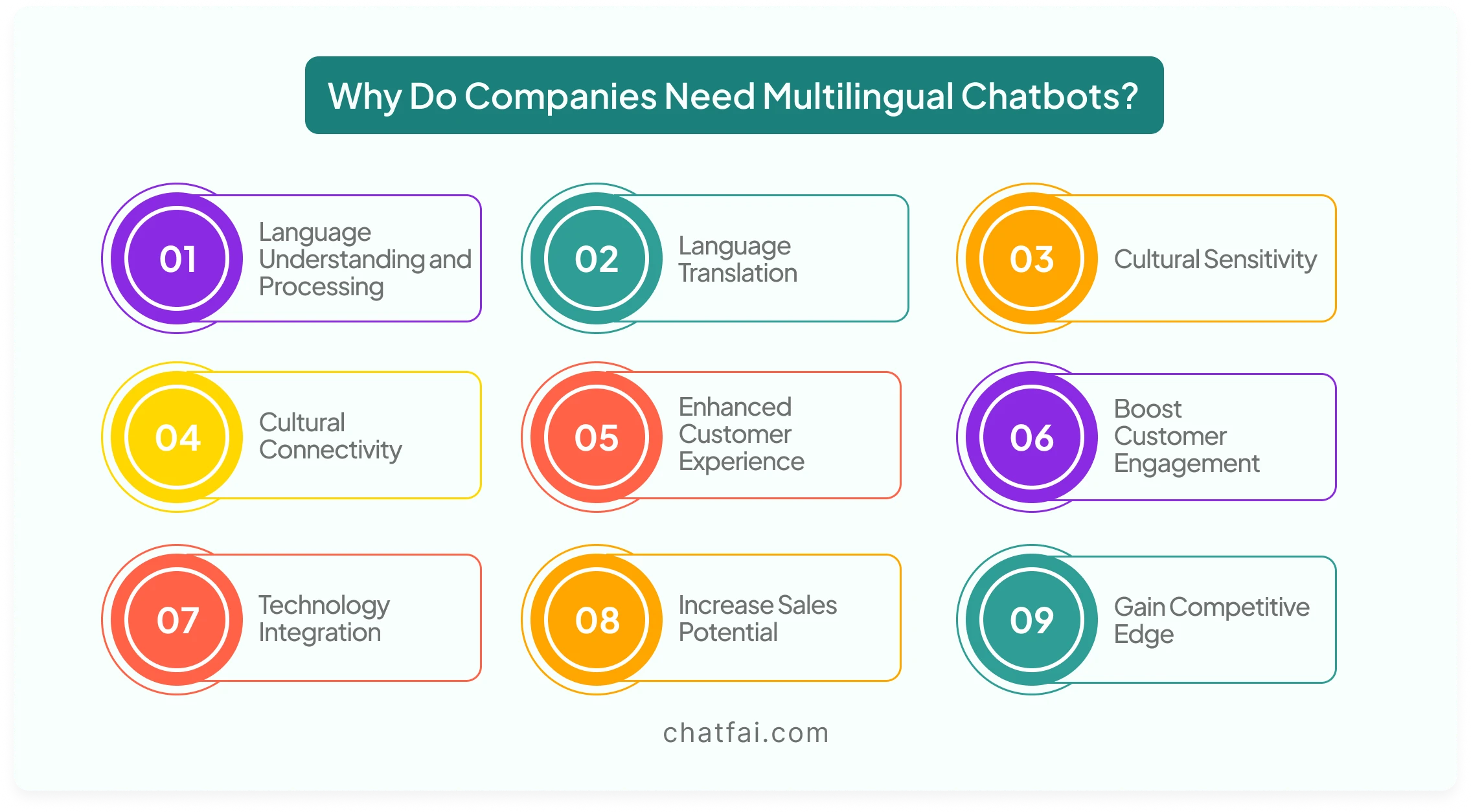Did you miss the last wristwatch you’ve been eyeing on for a long time just because you didn’t understand the language?
As physical boundaries are no longer existential, communicating across cultures has become more crucial. That’s why multilingual chatbots are becoming more crucial.
Multilingual chatbots are designed to break down the language barrier so you can stay connected with your clients, enroll in a dream course, or buy your favorite products.
This blog post will discuss how multilingual chatbots use AI to connect cultures. So, without further ado, let’s get into the topic.
What is a Multilingual Chatbot?
A multilingual chatbot is a conversational AI chatbot capable of engaging with customers on different platforms.

Simply put, a multilingual chatbot is an AI-powered virtual assistant that can converse with users in different languages instead of only speaking in English.
These chatbots can be integrated into websites to offer live and automated assistance in different languages. This feature lets your business grow in different markets globally.
But it’s important to understand how a multilingual chatbot works.
How Does a Multilingual Chatbot Works?
Multilingual chatbots uses Natural Language Processing (NLP) and machine learning algorithms.

To determine the intent behind each input, the algorithms are applied to its context, semantics, and syntax. The trained, multilingual chatbots use inherent input patterns and various linguistic nuances. A well-trained multilingual chatbot can easily generate a contextually relevant output in any language chosen by the user.
Now that we know how a multilingual chatbot works, it’s time to identify the fundamentals for a multilingual chatbot.
Fundamental of Multilingual Chatbot
Creating a chatbot that can assist users in different languages involves several core components. First, advanced language processing must be integrated to handle multiple language inputs.
Furthermore, the algorithm must be trained on a comprehensive database of languages and dialects. This helps the algorithm understand the nuances and context of different languages. Creating a multilingual chatbot also requires deep language knowledge, an understanding of culture, and technical proficiency in artificial intelligence and machine learning.
So, to create a multilingual chatbot, here are the key components that must be considered:
- Natural language processing (NLP)
- Language detection and translation
- Multilingual content management
- User interface
- Quality assurance and testing
Explore the top multilingual chatbots for businesses.
Why There Is a Need Of Multilingual Chatbots?
Companies need multilingual chatbots for multiple reasons, primarily to improve customer service and enhance global reach. Here are some of the benefits of having a multilingual chatbot to communicate without language restriction:

1. Language Understanding and Processing
Multilingual chatbots use NLP to understand and interpret user’s input in different languages. It can process the user’s query in different languages and respond according to the context.
2. Language Translation
Connected to the previous point, multilingual chatbots also serve as language chatbots. The smart bots can detect the language and translate phrases and paragraphs for you. This feature can be useful while learning a new language, travelling to a different country, or having an international business presence.
3. Cultural Sensitivity
Beyond language learning and translation, multilingual chatbots are designed to be culturally aware. The chatbots are smart enough to understand the language and cultural context and answer the questions accordingly. This improves the relevance and appropriateness of output.
4. Cultural Connectivity
Multilingual chatbots are a useful way to connect people across borders without having a language as a barrier. For example, you can connect with new people, make new friends, or have a diverse team worldwide using these chatbots.
5. Enhanced Customer Experience

People in different regions have different preferences, and culture plays a crucial role. Multilingual chatbots have diverse applications:
- E-commerce
- Customer support via calls and messages
- Healthcare
- Trip planning and tourism
Check out the benefits of AI chatbots for different businesses.
6. Boost Engagement
Language chatbots can help reach a wider audience and encourage users to interact with businesses. Customers prefer to shop again from platforms with little to no communication barrier, leading to customer loyalty and engagement.
Moreover, a multilingual chatbot can cater to diverse cultural backgrounds, making your platform more appealing to a global audience.
7. Gain Competitive Edge
Having a chatbot on your business page who can talk in multiple languages is a point to flex, isn’t it?
Multilingual chatbots can gain a competitive advantage through inclusivity and customer reach. Businesses can claim a customer-centric approach in their marketing to stand out among competitors.
8. Increase Sales Potential
These chatbots can increase your business’s sales potential by catering to a diverse audience. By facilitating smooth communication in different languages, multilingual chatbots can guide customers through purchasing and address real-time queries in the desired language.
9. Technology Integration
Multilingual chatbots integrate advanced technology, such as cloud computing, to learn and improve the input and answer accordingly. Moreover, technology integration assists in improving language detection capabilities.
Challenges of Multilingual Chatbots
Although multilingual chatbots have multiple benefits, here are some challenges:
- Complexity of NLP
- Quality and quantity of training data
- Error messages
- Ongoing updates and refinements
- Failure to understand cultural sensitivity
Final Verdict
That’s it!

Multilingual chatbots have become crucial for minimizing the language barrier. From helping an expat in translation to assisting a customer on a website, multilingual chatbots serve businesses that expand beyond borders.
Don’t know which multilingual chatbot you should try? Use ChatFAI, which is easy to integrate and will skyrocket your business growth, reach, and sales.
FAQs
What Is a Multilingual Chatbot?
A multilingual chatbot is similar to an AI chatbot but can understand multiple languages. By understanding user input, a multilingual chatbot provides contextually correct answers in multiple languages.
Can Chatbots Speak Other Languages?
Yes, multiple AI chatbots can assist in other languages. ChatFAI, ZenoChat, and Bard are multilingual chatbots.
What Is a Linguistic Chatbot?
Linguistic chatbots start conversations with users using “if or then” conditions. They define language requirements, generate conditions to interpret the words, and then provide answers according to the context.
What Is Multilingual TTS?
Multilingual TTS refers to a system’s ability to convert written text into speech. It is important to connect the world without communication as a hindrance.
What Is a Multilingual Conversation?
Multilingual conversation means the use of more than one language, either by an individual speaker or by a group of speakers, for communication. It reduces the language barrier and makes the conversation smooth. Several multilingual chatbots and TTS help to smooth this process. They help translate or convert written text into speech for convenience.